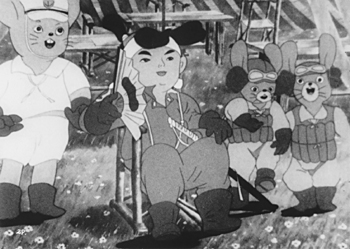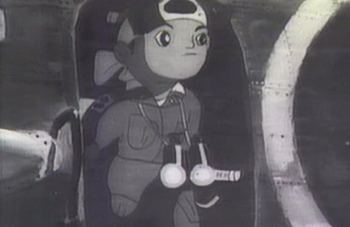Newly Digitally Restored WWII-Era Film Premiered at 2016 Cannes Film Festival Source: Funimation Entertainment press release Special Thanks to Scott Lonski
Funimation Entertainment is proud to announce its acquisition of the restored edition of Mitsuyo Seo’s MOMOTARO, SACRED SAILORS (??? ????, Momotaro Umi no Shinpei) -- the first feature-length animated film produced in Japan. Written and directed by Mitsuyo Seo (1911-2010), MOMOTARO, SACRED SAILORS was a propaganda film produced in 1944 by Shochiku Co. Ltd. and released in 1945 during the final months of World War II. Earlier this year, with the financial support of Funimation and others, Shochiku restored the 74-minute, black and white film, which premiered during opening weekend of the 2016 Cannes Film Festival in the Cannes Classics program. As part of its agreement with Shochiku, Funimation has secured exclusive rights to the theatrical, digital and home video distribution of the film in both the U.S. and Canada. “Mitsuyo Seo was a key figure in the development of Japan’s anime industry and were honored to have been part of the restoration of MOMOTARO, SACRED SAILORS -- one of his most famous works,” said Gen Fukunaga, CEO and founder of Funimation. “This wonderful black and white film was created using almost 50,000 cels and offers superb animation, music and entertainment that is on par with any classic Disney film of the same era.” Seo based the film’s story on the classic Japanese fairy tale of a boy named Momotaro, who was born from a peach and defeats monsters with the help of his animal friends. In Seo’s movie, Momotaro and his friends are now Japanese naval paratroopers and the monsters represent the Allied Powers. "This digitally restored version of Mitsuyo Seo’s MOMOTARO, SACRED SAILORS is truly captivating,” said Mike DuBoise, EVP and COO of Funimation. “Anime fans, film buffs and animators alike will not want to miss this seminal and historic work of Japanese animation.” Backed by Japan’s Ministry of the Navy, Shochiku produced MOMOTARO, SACRED SAILORS with a select crew of 70 that included Japanese animation pioneer Kenzo Masaoka (1898 - 1988) as director of shadowgraph. With a big budget at that time, the film was an animated epic on an unprecedented scale and was composed using almost 50,000 animation cels. Few saw the movie in theaters when it was released as most of Japan was fighting a war that would be lost just five months later. To create the restored print, Shochiku scanned a 35mm master print and internegative in 4K and restored it in 2K.
STORY
On the eve of a parachute mission during the final phase of the war in the Pacific, a group of navy paratroopers, a monkey, a dog, a pheasant and a bear, enjoy some rest and recreation in their hometown. A commotion breaks out when Santa, the monkey`s younger brother drops his navy cap in a river and is swept away after he dives in to retrieve it, but the villagers come to his aid and the boy is saved.
Before long, the mission is set in motion, and the four friends fly off to a tropical island on the South Pacific Front. Meanwhile, the indigenous animal inhabitants of the island are diligently building a base for the Japanese. Just as it is completed, the paratrooper squadron touches down on the new landing strip lead by boy warrior Momotaro. Inuta the dog teaches the indigenous animals a Japanese song, the bear devotes himself to combat training, and the days fly by on the island. The attack on the enemy`s lair on Devil`s Island is about to commence. After Momotaro and his comrades examine aerial photos of their target, we learn why they are called “sacred sailors.” Once upon a time, there was a beautiful island ruled over by the king of Goa. One day a strange black ship appeared in its waters. A white man from the ship came ashore and told the king that he and his crew were merchants. He proposed that they trade with each other, but as soon as the king agreed to this, they unfurled a skull and crossbones flag on the black ship and revealed that they were actually pirates. The pirates plundered the island and set it ablaze. All that remained was a legend that “sacred sailors will come from the east” who will “free the people.” Without a doubt, Momotaro and his compatriots are those sacred sailors. The attack finally begins. The paratrooper squadron takes to the air, bound for Devil`s Island. Momotaro and his men jump from their planes, and they subdue the enemy in no time at all. Momotaro forcefully lays down the law. “Surrender unconditionally, or continue to fight. Those are your only choices!” The flustered leaders of the horned, white devils swiftly submit. At last, peace returns to the South Pacific
A MESSAGE FROM MITSUYO SEO, WRITER AND DIRECTOR OF THE FILM circa 1984
I began making this film in September of 1943 when I joined a navy boot camp for paratroopers in order to carry out research for the script. I spent about a week with the unit, and was accompanied by the late great artist Saburo Miyamoto, who had been commissioned to make war?themed paintings. My observations of activities at the base, the interiors of planes, battle maneuvers and more formed the backbone of the film. I hit a snag when it came time to begin drawing the cels because most of the staff of SPIDER AND TULIP (Kumo to Churippu), who were scheduled to work on my film, had been conscripted by the military. For that reason, I called in art department staff from Shochiku`s Ofuna studio as well as members of Shochiku`s publicity department who had art skills and gave them a crash course in the craft of animation, and these makeshift animators enabled the production to continue. We started out with a crew of around 70. They all burned with the ambition to make Japan`s first feature?length animated film, and devoted themselves wholeheartedly to the endeavor. The entire sound for the film was prerecorded and a triple?level multiplane camera stand was used to shoot it’s about 50,000 cels, which were new technical approaches to animation in Japan. However, due to staff members being called up by the military during the making of the film, the production team got smaller and smaller, and only 20 remained by the time the film was completed. One animator died in combat at the South Pacific front, while one background artist was killed in an explosion at a munitions factory, and even after the war ended, the staff members who returned to Japan after being demobilized or discharged eventually passed away one after another without getting a chance to see the film, and [at the time of the film`s re?release in 1984] only nine are still alive that I am aware of. However, now this legendary animated film is no longer merely a legend. I`m overjoyed that this culmination of the strenuous efforts of its crew over 14 months has re?emerged into the light to be resurrected on the silver screen. 1945 / Black & White / 74 mins Written and Directed by Mitsuyo Seo Director of Shadowgraph: Kenzo Masaoka Construction: Kiichiro Kumaki Animation: Ryotaro Kuwata, Ichiro Takagi Music: Yuji Koseki Lyrics: Hachiro Sato Like Funimation on Facebook at facebook.com/funimation, and follow them on Instagram at instagram.com/funimation and Twitter at twitter.com/funimation.
About Funimation Entertainment
Funimation is the go-to destination for extraordinary anime. Combing its integrated in-house studios along with its technology and distribution partnerships, Funimation leads the industry with its omnichannel approach to offering anime -- from streaming and home entertainment to theatrical distribution and broadcast television. Its next generation streaming service, FunimationNow, provides subscribers with instant access to their favorite shows in ad-free HD on the widest array of devices and platforms.



